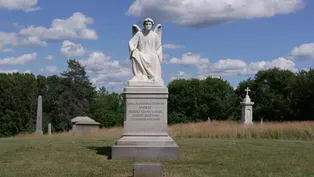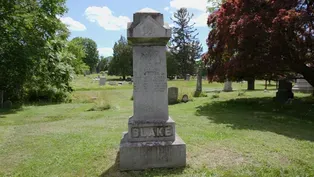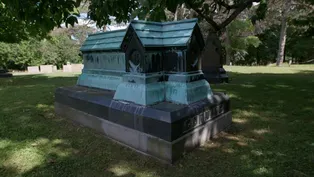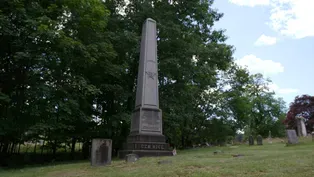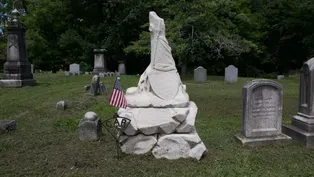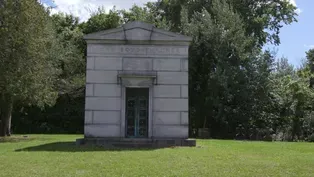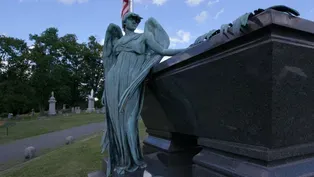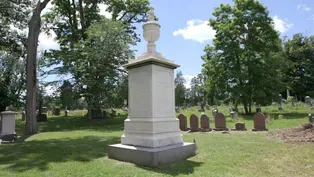Field Trip
Albany Rural Cemetery
Season 2 Episode 3 | 9m 59sVideo has Closed Captions
Learn about the National Historic Landmark, Albany Rural Cemetery.
The Producers of WMHT go out into the field and learn more about the National Historic Landmark of the Albany Rural cemetery.
Problems with Closed Captions? Closed Captioning Feedback
Problems with Closed Captions? Closed Captioning Feedback
Field Trip is a local public television program presented by WMHT
Support for Field Trip is brought to you by Frank and Sarah Slingerland.
Field Trip
Albany Rural Cemetery
Season 2 Episode 3 | 9m 59sVideo has Closed Captions
The Producers of WMHT go out into the field and learn more about the National Historic Landmark of the Albany Rural cemetery.
Problems with Closed Captions? Closed Captioning Feedback
How to Watch Field Trip
Field Trip is available to stream on pbs.org and the free PBS App, available on iPhone, Apple TV, Android TV, Android smartphones, Amazon Fire TV, Amazon Fire Tablet, Roku, Samsung Smart TV, and Vizio.
Providing Support for PBS.org
Learn Moreabout PBS online sponsorship- On today's episode of "Field Trip," I'm at the Albany Rural Cemetery, a National Historic Landmark.
My name's Joe.
I'm here along with my colleagues Greg, Nicole, and Matt.
- We're gonna head to the cemetery office, and speak with the cemetery's director Dave, who's gonna send us on a tour with some cemetery experts.
(upbeat music) - David.
- Matt, how are you today?
- Very good, how are you?
- Good to see you.
Doing well, thank you.
- So who are we gonna be talking to today?
- We're gonna talk to Mark Bodnar and Paula Lemire.
Mark is the president of the Friends Association.
He's also the vice president of the cemetery, and Paul Lemire, she is our historian for Friends.
- We were founded in 1841 and officially consecrated in 1845.
We're one of the early rural cemeteries, which was a movement in the mid 1800s to replace crowded overground burial grounds in cities.
And we actually, during the worst of the pandemic lockdown, we saw so many new visitors who were coming here because it was a safe, quiet place to just walk, get out and see nature, and also it's very scenic with the beautiful mausoleums and the statues, and we have our (indistinct) pond, so.
- Awesome.
(gentle music) Let's go take a look.
- Sure (chuckles).
(gentle music) - I'm Paul Grondahl, I'm the Director of the New York State Writers Institute at the University of Albany, but I spent 33 years as a reporter at the Times Union.
And while I was there, I worked on a book, a history of the Albany Rural Cemetery called "These Exalted Acres."
It was a really great learning experience for me because while I've been here to the cemetery many times and I knew quite a bit, I really learned from the people that know the cemetery best.
And if you take time, it does take time, but this book will help give you a little background.
The people at the cemetery office are really knowledgeable and very welcoming and helpful.
You can also find some things on their website.
You can really make it a day of discovery, of learning history and just enjoying nature.
- We're in section six here at Albany Rural Cemetery.
(pings) And we're at the grave of Lieutenant William Henry Pullman.
And he received a Lieutenantcy with the 59th New York Infantry.
Six months after being promoted to Lieutenant the man found himself at Gettysburg, and on July the 3rd 1863, Pullman was involved in Pickett's Charge, the spearhead of the Confederate attack.
He died on July the 21st of 1863 and his family brought him back here to be buried in this grave.
The iconography of this, the symbolism is incredible.
The two lower layers that you see here, those are rocks.
And they were things that the men would've erected prior to battle to give them some protection from incoming fire.
You'll see vines of ivy on both sides in the front and this tree stump.
It's in oak, and the oak tree symbolizes strength and immortality.
(birds singing) However, when the branches and trunk are severed, as you see here, they represent the end of a family line.
You see the military here, the flag, flagstaff, the shield.
And over on this side, the kepi that the soldiers wore.
(gentle music) So next grave we're gonna go to is right up the road.
It's for Stephen Van Rensselaer III, who is the founder of RPI.
- Did you know that there are over 14,000 graves that were moved from the state's three burial grounds to create Washington Park?
(gentle music) - So Paula, where are we now?
- This is the family lot of Stephen Van Rensselaer and this stone actually caps an underground vault.
And this vault is one of our favorite mysteries here.
It has been sealed since probably around, probably just before World War I and we don't really know who's down there.
We've sort of lost the entrance to it but we do know that there are about 100 years worth of Van Rensselaers, Skylars, Tenbrooks, and also Governor William Patterson of New Jersey, who was of course, a signer of the Constitution, who was the father-in-law of Stephen Van Rensselaer IV.
(chuckles) - Wow.
- Yes.
- That's quite a mystery.
- Yes.
We would love to find a way to look inside.
Of course, this is also one of the most visited lots not just because of Stephen III, but also because his first wife was Margaret Skylar, better known as Peggy, who attracted lot of Hamilton fans.
- Did you know that there are monuments in here designed by Albany architect, Marcus C Reynolds and Tiffany Studios?
(gentle music) - So tell us where we are now.
- Okay, now we're at the grave of Brigadier General James Clay Rice.
Then upon the outbreak of the Civil War in 1861 he entered the military with the 39th New York Infantry outta New York City.
Well, Rice is leading his men up to the Battle of Gettysburg.
Oh, probably 15, 20 minutes after arriving with his regiment, the brigade commander gets killed and command of the entire brigade, five regiments, devolves upon James Clay Rice.
These three lines on the gravestone.
"Last words while dying, (insects chirp) 'Turn me over.
Let me die with my face to the foe.'"
- [Matt] Wow!
- Very powerful statement for a man who, for 36 years old, he knew he was gonna die.
(gentle music) - Did you know that there are three civil war Confederate soldiers buried right here in Albany Rural Cemetery?
(gentle music) - This is the Blake family monument.
The Blake family, they were one of the most prominent African American families in Albany in the 19th century.
Adam Blake Sr was actually born enslaved.
He became the head of the household at the Van Rensselaer manor.
In fact, he led Stephen Van Rensselaer IIIs funeral procession in 1839.
His son, Adam Blake, Jr. went into the hospitality industry.
Obviously he would've learned quite a bit from his father's management of the manor house and he went into the hotel business.
He owned a hotel close to the capital which was frequented by the legislature.
When the new capital was built that building had to be torn down and he used the settlement that he got for that building to build what is now the Kenmore Hotel which of course today still stands, and it's one of the most iconic buildings on North Pearl Street, and of course, as we know, it's been rehabbed beautifully, but the Kenmore Hotel is his legacy.
And even his wife, she was a very strong-willed, intelligent woman, she lost her father at a young age.
He was a barber who was killed in a shipwreck.
When Blake died shortly after the death of one of their children, she took over management of the hotel and ran it successfully for a time after his death.
(gentle music) - Did you know that some of the tombstones here date back to the 1720s and some of them are even written in Dutch?
- Millionaires Row originally was called Mount Auburn Avenue.
It was named after the original rural cemetery, but over the years, it became popularly known as Millionaires Row because of all of these grand vaults that families would build along here.
And this one is the vault of John Boyd Thatcher who was one of the better known mayors of Albany.
Not only was he Mayor of Albany, he was the son of a mayor and he was the uncle of a mayor.
So the family had quite a role in early Albany politics.
- Did you know that they're up to 100 revolutionary war veterans buried here?
- This is what I like to refer to as our main attraction.
This is the grave site of President Chester Alan Arthur.
He was 21st President of the United States.
And I think the number one question we get about him is "Why is he here in Albany?"
His father, Reverend William Arthur, was pastor of a church in what's now Newtonville.
So Arthur spent a lot of his youth in this area.
He was a teacher in this area.
He attended Union College.
So his family had a plot here and before he became vice president his wife Nell died very young.
And of course she was buried in the family plot.
Arthur only served one term as president, partly due to health reasons.
He had a severe kidney ailment and he died very shortly after leaving office.
So his wish was to be buried with his wife, Ellen.
So, after a funeral in New York City, his body was brought up here by train for the burial here in Albany.
The monument was erected after his burial.
Money was raised by friends and donors.
The monument was designed by Ephraim Keyser and it represents an angel laying a palm of victory on the tomb.
And the tomb of course, has that very classical design.
However, contrary to belief, he is not buried inside that granite tomb.
- Where is he buried?
- He is buried right behind the tomb next to his wife, Ellen.
And Arthur is basically buried right between us.
(chuckles) He is buried, this is his wife's monument, his wife, Ellen.
It's a marble sarcophagus.
It has this beautiful, somewhat Gothic style to it.
And Arthur's grave, according to illustrations, we have there contemporary to his funeral was laid right next to hers.
(gentle music) - Thank you for joining us on this episode of "Field Trip."
- Submit your ideas at wmht.org/fieldtrip and tell us where you think we should go next.
(gentle music)
Video has Closed Captions
Clip: S2 Ep3 | 2m 11s | Angel at the Sepulchre by Erastus Dow Palmer. (2m 11s)
Video has Closed Captions
Clip: S2 Ep3 | 1m 17s | Generations of the Blake family are buried here at Albany Rural Cemetery. (1m 17s)
Video has Closed Captions
Clip: S2 Ep3 | 1m 33s | Corning Family Plot: Five generations of Albany Impact. (1m 33s)
The Gravestone of General Rice
Video has Closed Captions
Clip: S2 Ep3 | 2m 14s | James Clay Rice, a Civil War casualty, buried at Albany Rural Cemetery. (2m 14s)
Gravestone of Lieutenant William Pohlman
Video has Closed Captions
Clip: S2 Ep3 | 2m 13s | The grave of Lt. William Pohlman at Albany Rural Cemetery is one of many civil war graves. (2m 13s)
Video has Closed Captions
Clip: S2 Ep3 | 53s | The John Boyd Thatcher Mausoleum sits on 'millionaires' row in Albany Rural Cemetery. (53s)
President Chester Alan Arthur Grave Site
Video has Closed Captions
Clip: S2 Ep3 | 57s | Chester Alan Arthur: 21st President of the United States gravesite, Albany Rural Cemetery. (57s)
Video has Closed Captions
Clip: S2 Ep3 | 1m 21s | The Van Rensselaer family plot has several prominent names buried on the grounds. (1m 21s)
Providing Support for PBS.org
Learn Moreabout PBS online sponsorshipSupport for PBS provided by:
Field Trip is a local public television program presented by WMHT
Support for Field Trip is brought to you by Frank and Sarah Slingerland.
